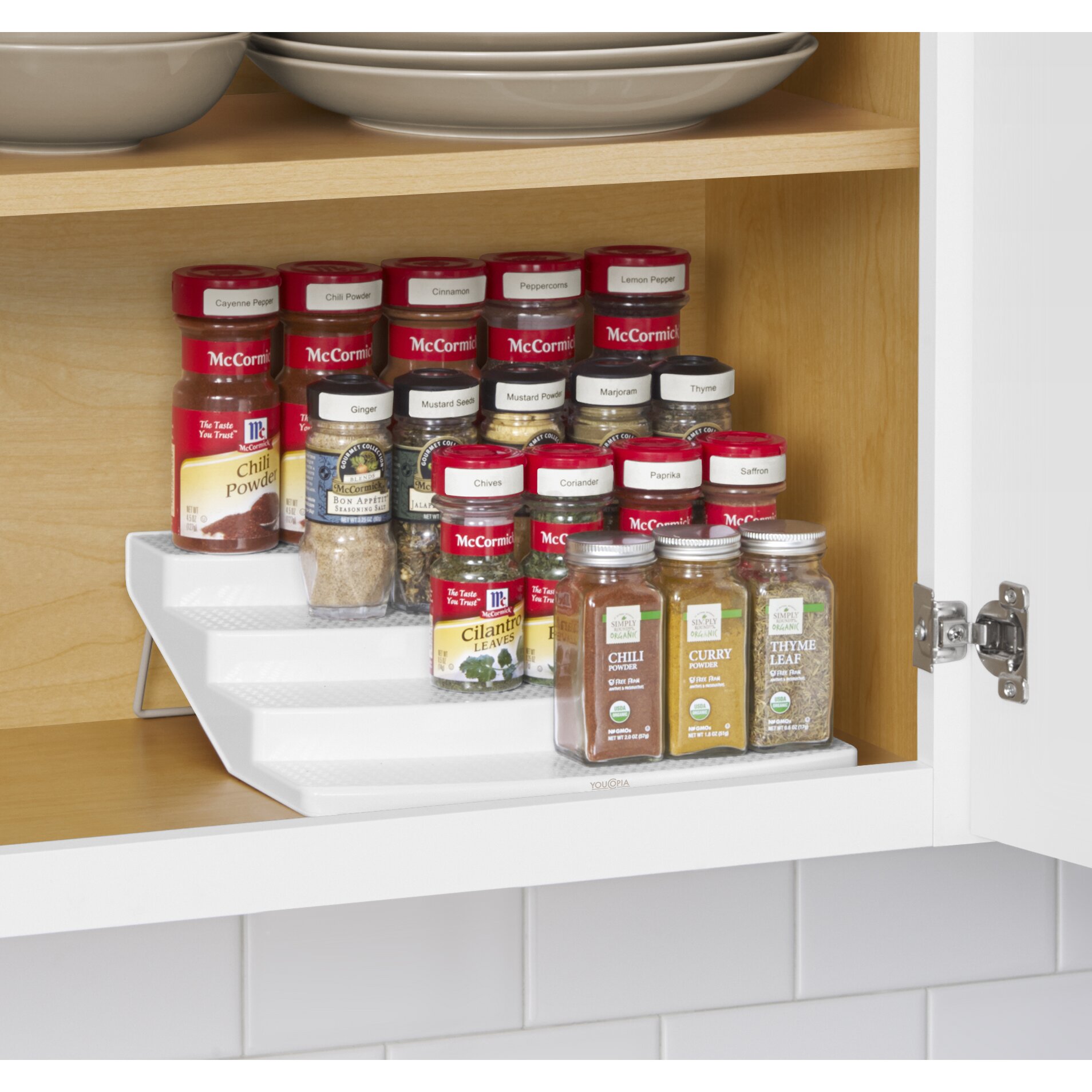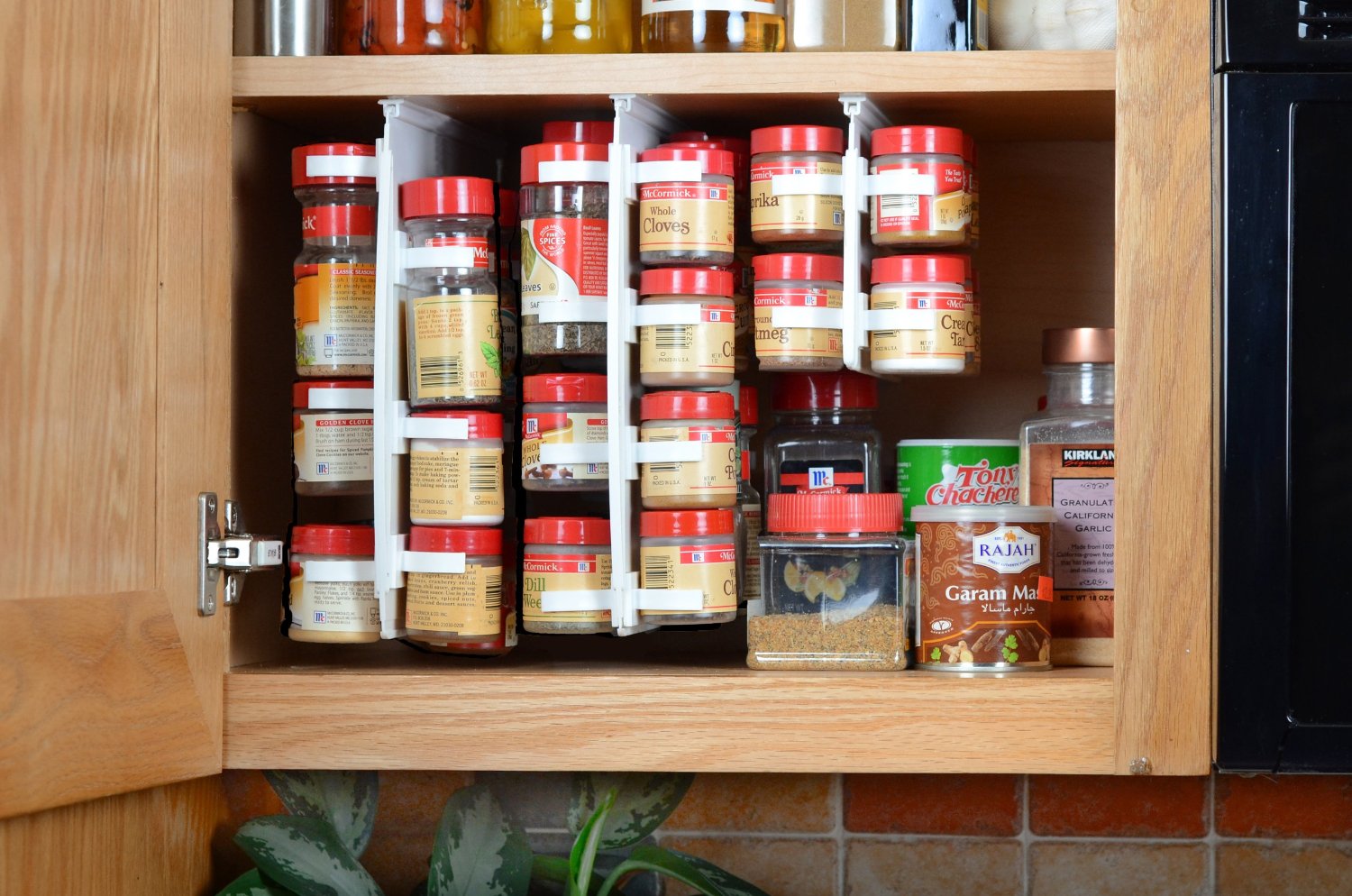Design & Functionality of On-Cabinet Door Spice Racks

On-cabinet door spice racks offer a space-saving and convenient solution for organizing spices in kitchens. Their design and functionality are crucial for efficient use and aesthetic appeal. This section explores various models, installation methods, and the advantages and disadvantages of different mounting approaches.
Spice Rack Model Variations
Several models of on-cabinet door spice racks cater to diverse needs and kitchen styles. These variations consider factors such as material, size, and spice storage capacity. Careful consideration of these aspects ensures the selection of a rack that optimally fits available space and storage requirements.
| Material | Dimensions (approx.) | Capacity (approx.) | Notable Features |
|---|---|---|---|
| Bamboo | 12″ W x 4″ D x 6″ H | 12-15 standard spice jars | Sustainable, lightweight, natural aesthetic |
| Stainless Steel | 16″ W x 5″ D x 7″ H | 20-25 standard spice jars | Durable, easy to clean, modern look |
| Wire (Metal) | 10″ W x 3″ D x 5″ H | 10-12 small spice jars | Lightweight, inexpensive, good ventilation |
| Acrylic | 14″ W x 4″ D x 6″ H | 15-20 standard spice jars | Clear visibility, modern and sleek appearance |
Installation Methods for On-Cabinet Door Spice Racks
The installation process varies depending on the rack’s mounting type. Understanding the specific steps for each method ensures a secure and stable installation. Improper installation can lead to instability or damage to the cabinet door.
On cabinet door spice rack – Adhesive-Mounted Spice Racks: These racks utilize strong adhesive strips for attachment. This method is generally preferred for its ease of installation and lack of drilling requirements. However, it may not be suitable for heavier racks or cabinets with delicate surfaces.
- Clean the cabinet door surface thoroughly with a degreasing agent.
- Allow the surface to dry completely.
- Apply the adhesive strips to the back of the spice rack, following the manufacturer’s instructions.
- Firmly press the rack against the cabinet door, ensuring even contact.
- Allow the adhesive to set for the recommended time before loading the rack with spices.
Drilling-Mounted Spice Racks: These racks require drilling holes into the cabinet door for secure attachment. This method provides superior stability, especially for heavier racks, but requires more skill and preparation.
- Measure and mark the locations for the mounting holes on the cabinet door.
- Pre-drill pilot holes at the marked locations to prevent splitting the wood.
- Attach the mounting bracket to the cabinet door using appropriate screws.
- Hang the spice rack onto the mounted bracket.
- Ensure all screws are securely tightened.
Advantages and Disadvantages of Mounting Methods
The choice between adhesive and drilling methods depends on several factors. A thorough understanding of the strengths and weaknesses of each approach is crucial for making an informed decision.
Adhesive Mounting:
- Advantages: Easy installation, no drilling required, reversible (with appropriate adhesive).
- Disadvantages: May not be suitable for heavy racks, adhesive may fail over time or with high temperatures, may not work on all surfaces.
Drilling Mounting:
- Advantages: Provides superior stability and load-bearing capacity, suitable for heavier racks, more permanent solution.
- Disadvantages: Requires drilling, potentially damaging the cabinet door if improperly done, not easily reversible.
Spice Organization & Management Using On-Cabinet Door Spice Racks

Efficient spice organization is crucial for ease of cooking and maintaining a well-stocked kitchen. On-cabinet door spice racks, while space-saving, require a strategic approach to maximize their utility and prevent a chaotic jumble of containers. Proper organization ensures quick identification of spices and prevents spoilage due to overlooked, expired items.
Effective spice management within an on-cabinet door rack involves a combination of careful planning, consistent labeling, and strategic arrangement. This ensures easy access to frequently used spices while maintaining a visually appealing and functional system.
Labeling Systems for Spices
A clear and consistent labeling system is paramount for efficient spice management. Inconsistent or missing labels lead to wasted time searching for specific spices. Several effective labeling methods exist, each offering advantages depending on personal preference and the type of spice containers used. Consider using pre-printed labels, handwritten labels with waterproof ink, or even creating custom labels using a label maker for a more professional look. Regardless of the method, ensure labels are legible, clearly indicating the spice name and, ideally, the date of purchase for better stock management. Using a uniform font and size across all labels enhances visual appeal and ease of identification.
Spice Arrangement Strategies
The arrangement of spices within the rack should be based on frequency of use and culinary preferences. Frequently used spices should be placed in easily accessible locations, ideally at eye level or within arm’s reach. Organize spices by category (e.g., herbs, baking spices, savory spices) or by cuisine type (e.g., Italian, Mexican, Indian). This arrangement facilitates quicker retrieval during recipe preparation. Another approach is arranging spices alphabetically, which is particularly useful for larger collections. Consider color-coding for a visually pleasing and easily navigable system.
Visual Representation of an Optimally Organized Spice Rack
Imagine a spice rack with three shelves. The top shelf contains frequently used spices such as salt, pepper, garlic powder, and onion powder, arranged alphabetically from left to right. The middle shelf holds baking spices (cinnamon, nutmeg, cloves) arranged alphabetically. The bottom shelf contains less frequently used spices, categorized by cuisine type (Italian herbs on one side, Mexican spices on the other). All containers are uniformly sized and labeled clearly with both the spice name and purchase date. This arrangement prioritizes accessibility and visual clarity, making it easy to locate any spice quickly.
Managing Different Spice Container Sizes and Shapes, On cabinet door spice rack
On-cabinet door spice racks often accommodate a variety of container sizes and shapes. To optimize space and maintain order, consider using uniform containers. Transferring spices into identical jars or containers creates a visually appealing and space-efficient arrangement. This method also makes it easier to label and organize the spices. If using a variety of containers, arrange them strategically, placing larger containers at the bottom or in areas with more space and smaller containers on higher shelves. Avoid overcrowding the rack, which can lead to instability and make it difficult to access individual spices. Employ dividers or separators if necessary to create designated spaces for different-sized containers.
Aesthetic Considerations & Integration with Kitchen Design: On Cabinet Door Spice Rack

The aesthetic appeal of an on-cabinet door spice rack is crucial for maintaining a cohesive and visually pleasing kitchen. A well-chosen rack not only provides practical storage but also enhances the overall design of the space, complementing existing décor and adding a touch of personality. The style of the rack should harmonize with the kitchen’s theme, creating a unified and stylish look.
Different on-cabinet door spice rack styles can effectively complement various kitchen decor themes. A sleek, minimalist rack with chrome or brushed stainless steel finish seamlessly integrates into a modern kitchen with its clean lines and contemporary appliances. Conversely, a rustic wooden rack with a distressed finish adds warmth and character to a farmhouse-style kitchen, echoing the natural materials and cozy ambiance. For a transitional kitchen blending modern and traditional elements, a rack with a combination of materials, such as dark wood and brushed nickel, can provide a balanced and sophisticated aesthetic.
Spice Rack Design Examples
The following designs illustrate the versatility of on-cabinet door spice racks in enhancing kitchen aesthetics:
Design 1: Modern Minimalist Spice Rack
This rack features a slim, rectangular profile crafted from brushed stainless steel. The spice jars are held in place by small, discreet clips, maintaining a clean and uncluttered appearance. The minimalist design prioritizes functionality and sleek aesthetics, ideal for a modern or contemporary kitchen. The brushed steel finish resists fingerprints and complements stainless steel appliances.
Design 2: Rustic Farmhouse Spice Rack
This rack is constructed from reclaimed wood with a natural, slightly distressed finish. The wood’s unique grain patterns and imperfections add character and warmth. Small, wrought-iron brackets provide support and subtly complement the rustic aesthetic. This design perfectly suits a farmhouse, country, or cottage-style kitchen, adding a touch of vintage charm.
Design 3: Transitional Spice Rack
This rack combines dark stained wood shelves with sleek, brushed nickel metal supports. The contrast between the warm wood and cool metal creates a visually interesting and balanced design. This style seamlessly blends modern and traditional elements, making it suitable for a transitional or eclectic kitchen. The dark wood adds richness, while the brushed nickel maintains a contemporary feel.
Rewritten Article on On-Cabinet Door Spice Racks
Let’s talk about those handy on-cabinet door spice racks! They’re a fantastic way to keep your spices organized and within easy reach, but choosing the right one can make all the difference. Think about how much space you have – some racks are super slim, perfect for smaller kitchens, while others offer more room for a larger spice collection. You’ll also want to consider how you use your spices. Do you grab them frequently? If so, a rack that’s easy to access is key.
Material is another important factor. Do you prefer the clean look of stainless steel, the warmth of wood, or something else entirely? The style of your kitchen should definitely influence your choice. A sleek, modern rack will look great in a contemporary kitchen, while a rustic wooden rack will add charm to a farmhouse setting. Think about the overall feel you want to create and choose a rack that fits in perfectly. Ultimately, the best spice rack is the one that works best for you, keeping your spices organized and your kitchen looking great!
